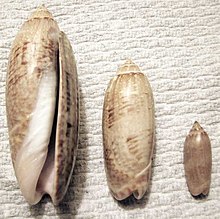Olive snail: Difference between revisions
GrahamBould (talk | contribs) mNo edit summary |
GrahamBould (talk | contribs) mNo edit summary |
||
| Line 18: | Line 18: | ||
}} |
}} |
||
'''Olive shells''', '''olive snails''', or '''olives''', scientific name '''Olividae''', are a |
'''Olive shells''', '''olive snails''', or '''olives''', scientific name '''Olividae''', are a [[family (biology)|family]] of minute to large [[predatory]] sea [[snail]]s with smooth, shiny, oval-shaped shells. The shells often show various muted but attractive colors, and may be patterned also. |
||
Scientifically speaking, these animals are [[Marine (ocean)|marine]] [[gastropod]] [[mollusc]]s in the [[family (biology)|family]] [[Olividae]], within the order [[Sorbeoconcha]], specifically the infraorder [[Neogastropoda]]. |
Scientifically speaking, these animals are [[Marine (ocean)|marine]] [[gastropod]] [[mollusc]]s in the [[family (biology)|family]] [[Olividae]], within the order [[Sorbeoconcha]], specifically the infraorder [[Neogastropoda]]. |
||
| Line 29: | Line 29: | ||
==Life habits== |
==Life habits== |
||
The |
The olive snails are all [[carnivorous]] sand-burrowers. They feeding mostly on [[bivalve]]s and [[carrion]] and are known as some of the fastest burrowers among snails. They secrete a mucus similar to that of the [[Muricidae]], from which a purple dye can be made. |
||
==Shell description== |
==Shell description== |
||
| Line 42: | Line 42: | ||
Olive shells are popular with [[Conchology|shell collectors]], and are also often made into jewellry and other decorative items. |
Olive shells are popular with [[Conchology|shell collectors]], and are also often made into jewellry and other decorative items. |
||
The shell of the [[lettered olive]], ''Oliva sayana'', is the [[List of U.S. state shells|state shell]] of [[South Carolina]] in the [[United States]]. |
The shell of the [[lettered olive]], ''[[Oliva sayana]]'', is the [[List of U.S. state shells|state shell]] of [[South Carolina]] in the [[United States]]. |
||
==Genera== |
==Genera== |
||
Revision as of 15:06, 23 December 2007
| Olive shell | |
|---|---|

| |
| Lettered olive, Oliva sayana | |
| Scientific classification | |
| Kingdom: | |
| Phylum: | |
| Class: | |
| Subclass: | |
| Superorder: | |
| Order: | |
| Suborder: | |
| Infraorder: | |
| Family: | Olividae Latreille, 1825
|
| Genera | |
|
See text. | |
Olive shells, olive snails, or olives, scientific name Olividae, are a family of minute to large predatory sea snails with smooth, shiny, oval-shaped shells. The shells often show various muted but attractive colors, and may be patterned also.
Scientifically speaking, these animals are marine gastropod molluscs in the family Olividae, within the order Sorbeoconcha, specifically the infraorder Neogastropoda.
Distribution
Olive snails are found worldwide, in subtropical and tropical seas and oceans.
Habitat
These snails are found on sandy substrates intertidally and subtidally.
Life habits
The olive snails are all carnivorous sand-burrowers. They feeding mostly on bivalves and carrion and are known as some of the fastest burrowers among snails. They secrete a mucus similar to that of the Muricidae, from which a purple dye can be made.
Shell description
Physically the shells are oval and cylindrical in shape. They have a well-developed stepped spire. Olive shells have a siphonal notch at the posterior end of the aperture from which protudes the siphon.
The shell surface is extremely glossy because in life the mantle almost always covers the shell.[1][2]
The fossil record
Olive Shells first appeared during the Campanian.[3]
Human use
Olive shells are popular with shell collectors, and are also often made into jewellry and other decorative items.
The shell of the lettered olive, Oliva sayana, is the state shell of South Carolina in the United States.
Genera
-
Variable dwarf olive, Olivella mutica
-
Lettered olive, Oliva sayana
-
Brown olive, Oliva reticularis bifasciata
Notes
- ^ Washington State University Tri-Cities Natural History Museum (2001). Family: Olividae (Olive Shells). Retrieved on 12 July 2006.
- ^ Vermeij, Geerat J (3 April 1995). A Natural History of Shells. Princeton University Press. ISBN 0-691-00167-7. pps. 89, 100, 114.
- ^ Vermeij, Geerat J (1 September 1993). Evolution and Escalation. Princeton University Press. ISBN 0-691-00080-8. p.182.

